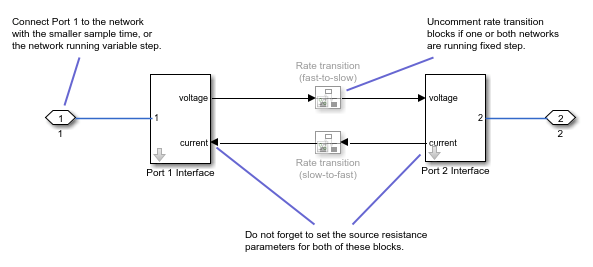Network Coupler (Voltage-Voltage)
Libraries:
Simscape /
Utilities /
Network Couplers
Description
The Network Coupler (Voltage-Voltage) block provides a starting point for you to split a Simscape™ network into two coupled networks at an electrical connection. Use this block for splitting power networks where connection cables are modeled as resistors and inductors connected in series, and where parts of the network do not have a local electrical reference connection. The inductances in this type of scenario do not allow the use of current sources at the interface, and therefore this block presents a voltage source to both networks.
You cannot simply drive the voltage source for Network 2 based on a voltage measurement for Network 1 (and the other way around) because then the definition is cyclic and contains no constraint on the currents flowing into the two networks, which must sum to zero. To introduce the constraint on currents, the two voltage sources have an added internal source resistance.
The discrete-time equations defining the values of the two voltage sources are:
where:
Vs1, Vs2 — Voltages of the two internal sources.
R1, R2 — Resistances of the two internal sources.
i1, i2 — Currents flowing from the connected networks into the sources.
V1, V2 — Voltages presented to the connected networks.
n — Sample number.
When there is no load connected to either side, then the poles are at
+-1, that is, on the unit circle. The connected network can act to either
stabilize the poles (they end up inside the unit circle), or destabilize (they end up outside
of the unit circle).
Generally, it is best when the series inductances and resistances of the two coupled networks are approximately equal because this results in the slowest set of closed-loop poles.
Both of the port interfaces of the Network Coupler (Voltage-Voltage) block are implemented as voltage sources. Therefore, you cannot connect this block to a voltage loop, such as a set of series-connected voltage sources and capacitors, because this would cause an Index-2 topology (for more information, see Avoiding Numerical Simulation Issues).
To facilitate working with models that contain arrays of electrical nodes or three-phase connection, the Port 1 Interface and Port 2 Interface subsystems contain custom blocks, such as Controlled Voltage Source or Current Sensor. These custom blocks are based on the equivalent Foundation library blocks but are modified to support vectorized and three-phase electrical nodes. The source files for these custom blocks are located in the following namespace:
matlabroot/toolbox/physmod/simscape/library/m/+foundation/+internal/+couplers/+electrical
where matlabroot is the MATLAB® root directory on your machine, as returned by entering
matlabroot
at the MATLAB command prompt. The namespace contains source files for voltage and current sources and sensors, as well as a resistor and an electrical reference with array and three-phase support. You can use these blocks to customize your network coupler configuration.
Working with the Block on the Model Canvas
When you add the block to your model and double-click it, the Network Coupler (Voltage-Voltage) subsystem opens.

The Port 1 Interface block contains the dynamics that break the algebraic loop. Double-click this block to set most of the Network Coupler (Voltage-Voltage) subsystem parameters and view the derived values.
However, unlike most of the other coupler blocks, the Port 2 Interface block also has one parameter, Port 2 voltage source resistance (ohms), which you need to set separately.
The rate transition blocks are, by default, commented through. Uncomment them if at least one of the coupled networks is running fixed step.
Using the Derived Values to Estimate Block Parameters
The Analysis tab asks you for information about the series-connected resistance and inductance of the two coupled networks and provides advice on values of R1 and R2, to ensure stability. If at least one of your coupled networks has switching, then use the smallest series resistance value and the largest series inductance value.
For most applications, following the recommended values results in a stable simulation, but on occasion you may need to experiment with values for R1 and R2.
The Update button lets you recalculate the derived values after you change the parameters of the connected networks.